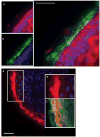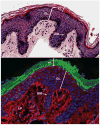Keratinization of the adult male foreskin and implications for male circumcision
- PMID: 20098294
- PMCID: PMC2951978
- DOI: 10.1097/QAD.0b013e3283367779
Keratinization of the adult male foreskin and implications for male circumcision
Abstract
Objective: The theory that a more thinly keratinized inner foreskin leads to increased HIV-1 susceptibility has been based on relatively little published data. We sought to quantify the keratin thicknesses of the inner and outer foreskin to determine the plausibility of this hypothesis.
Design: We took repeated measurements of the keratin layer of 16 adult male foreskins to determine whether differences existed between the inner and outer foreskin.
Methods: Adult foreskins were collected from consenting donors undergoing elective male circumcision for unknown medical indications in Chicago, Illinois, USA. Specimens were processed, sectioned and stained for keratin using antifilaggrin fluorescent antibodies. Slides stained with hematoxylin and eosin were used as controls and compared with results from previously published studies using this method. Keratin layers were measured in a standardized fashion for each specimen.
Results: Comparing our fluorescence-based analysis with previously published immunohistochemical methods revealed that our method was highly accurate for measuring foreskin keratin thickness. There was significant heterogeneity in the keratin thickness of the inner and outer aspects of the male foreskin within and between the different donors. There was no significant difference between the inner and outer foreskin keratin thickness (25.37 +/- 12.51 and 20.54 +/- 12.51 microm, respectively; P = 0.451).
Conclusion: We found no difference between the keratinization of the inner and outer aspects of the adult male foreskin. Keratin layers alone are unlikely to explain why uncircumcised men are at higher risk for HIV infection.
Conflict of interest statement
Comment in
-
Keratinization of the adult male foreskin and implications for male circumcision.AIDS. 2010 Jun 1;24(9):1381; author reply 1381-2. doi: 10.1097/QAD.0b013e3283392555. AIDS. 2010. PMID: 20559044 No abstract available.
Similar articles
-
No difference in keratin thickness between inner and outer foreskins from elective male circumcisions in Rakai, Uganda.PLoS One. 2012;7(7):e41271. doi: 10.1371/journal.pone.0041271. Epub 2012 Jul 18. PLoS One. 2012. PMID: 22815984 Free PMC article.
-
Langerhans' cell density and degree of keratinization in foreskins of Chinese preschool boys and adults.Int Urol Nephrol. 2009 Dec;41(4):747-53. doi: 10.1007/s11255-008-9521-x. Epub 2009 Jan 30. Int Urol Nephrol. 2009. PMID: 19184514
-
Potential HIV-1 target cells in the human penis.AIDS. 2006 Jul 13;20(11):1491-5. doi: 10.1097/01.aids.0000237364.11123.98. AIDS. 2006. PMID: 16847403
-
The role of the foreskin in male circumcision: an evidence-based review.Am J Reprod Immunol. 2011 Mar;65(3):279-83. doi: 10.1111/j.1600-0897.2010.00934.x. Epub 2010 Nov 28. Am J Reprod Immunol. 2011. PMID: 21114567 Free PMC article. Review.
-
Biological basis for the protective effect conferred by male circumcision against HIV infection.Int J STD AIDS. 2012 Mar;23(3):153-9. doi: 10.1258/ijsa.2011.011228. Int J STD AIDS. 2012. PMID: 22581866 Review.
Cited by
-
Expression of structural proteins in human female and male genital epithelia and implications for sexually transmitted infections.Biol Reprod. 2012 Feb 9;86(2):32. doi: 10.1095/biolreprod.111.094789. Print 2012 Feb. Biol Reprod. 2012. PMID: 21976595 Free PMC article.
-
No difference in keratin thickness between inner and outer foreskins from elective male circumcisions in Rakai, Uganda.PLoS One. 2012;7(7):e41271. doi: 10.1371/journal.pone.0041271. Epub 2012 Jul 18. PLoS One. 2012. PMID: 22815984 Free PMC article.
-
Circumcision and acquisition of human papillomavirus infection in young men.Sex Transm Dis. 2011 Nov;38(11):1074-81. doi: 10.1097/OLQ.0b013e31822e60cb. Sex Transm Dis. 2011. PMID: 21992987 Free PMC article.
-
Sexually transmitted infections and male circumcision: a systematic review and meta-analysis.ISRN Urol. 2013 Apr 16;2013:109846. doi: 10.1155/2013/109846. Print 2013. ISRN Urol. 2013. PMID: 23710368 Free PMC article.
-
Male circumcision and human immunodeficiency virus infection: An update on randomized controlled trials and molecular evidences.Int J Health Sci (Qassim). 2018 Jan-Feb;12(1):1-3. Int J Health Sci (Qassim). 2018. PMID: 29623010 Free PMC article. No abstract available.
References
-
- Donoval BA, Landay AL, Moses S, Agot K, Ndinya-Achola JO, Nyagaya EA, et al. HIV-1 Target Cells in Foreskins of African Men With Varying Histories of Sexually Transmitted Infections. Anatomic Pathology. 2006;125:386–391. - PubMed
-
- McCoombe SG, Short RV. Potential HIV-1 target cells in the human penis. AIDS. 2006;20:1491–1495. - PubMed
Publication types
MeSH terms
Substances
Grants and funding
LinkOut - more resources
Full Text Sources
Medical





